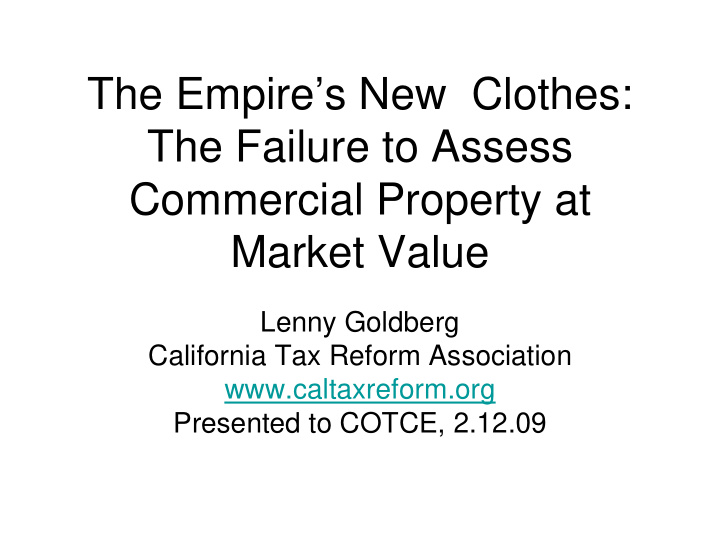



The Empire’s New Clothes: The Failure to Assess Commercial Property at Market Value Lenny Goldberg California Tax Reform Association www.caltaxreform.org Presented to COTCE, 2.12.09
Policy failure at every level • The opposite of good economics • Legal morass • Fiscal policy failure • Land use distortions
Bad economics: taxing investment not land rents • New investment: assessed at full market value, pays fees and exactions, sales and property tax on new equipment, inflated land values • Land rents untaxed, i.e benefits accruing from the investment of others, private and public • Competitors assessed at huge differentials, mostly on land
SF: downtown office buildings Disparities in Property Taxes Paid for Select San Francisco Office Buildings $18.00 $15.90 Estimated Tax Paid Per Sq. Ft. $16.00 2002-03 $14.00 Estimated Tax $11.16 $12.00 Per Sq. Ft. of $9.72 Land $10.00 2002-03 $8.00 Estimated Tax $6.00 Per Sq. Ft. of $3.60 $3.19 $3.14 Structure $4.00 $2.92 $1.71 $1.48 $2.00 $0.15 $0.00 Hallidie Building (130-150 Sutter St.) Chevron Building (101 Montgomery St.) Transamerica Pyramid (600 Montgomery St.) First Market Tower (525 Market St.) Bank of America Building (555 California St.)
Legal morass • “Change of ownership” inapplicable to complex ways of holding property: publicly-traded corps, LLCs, Sub S, limited partnerships, REITs, etc. • Martini to Gallo: 100% sold, partners to partners, no reassessment • Changes easy to effectuate when values are low: downtown LA, early 90’s. • Can be reformed statutorily but still messy
Fiscal failure • Economic growth does not pay for itself— generates land value increases but not local revenue increases=no-growth politics • Virtuous cycle of infrastructure is short- circuited: public investment in land capacity gets insufficient return • Burden shift to residential housing
Environmentally unsound land economics • No penalty for withholding land from market, promotes speculation and sprawl • Land values inversely related to tax burden, thus land value inflation • Low-value infill uses maintained • Big box retailing: best fiscally, worst land- use • “Highest and best use” avoided
Simple policy solution • “Non-residential property shall be periodically assessed at market value” • Unlike housing, reflects stream of future earnings from land • Allocated currently by Props 1A and 98 • Issues: rental residential, farms (Williamson Act), transition (assessors) • Revenues: poor data: $6 billion?
Economic impacts • Shefrin: “very close to the economists’ ideal of non-distorting taxes” • Lower land costs • Lower development costs, better approval climate • Infrastructure finance significantly improved • Competitors taxed equivalently • Costs borne by those with locational advantages: retail, hotels, offices • Potential trade-off: personal property relief (small business, relieves assessors)
The Empire’s New Clothes • SD Union-Trib: “Even Prop. 13 Must be on the table”: “While Democrats and Republicans cower before this iconic restriction on property taxes, they should nevertheless be amenable to an annual reassessment of business and commercial properties . There can be no sacred cows in confronting California’s catastrophic budget”. • PPIC Polling: Should commercial property be taxed on the basis of market value? Yes 60, no 34
Recommend
More recommend